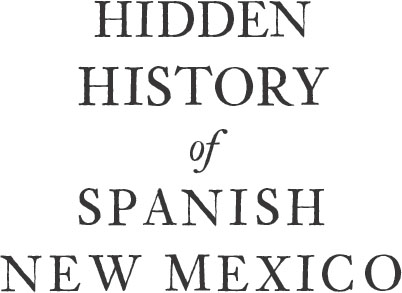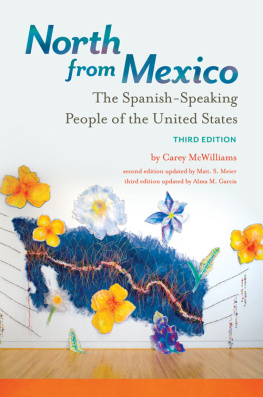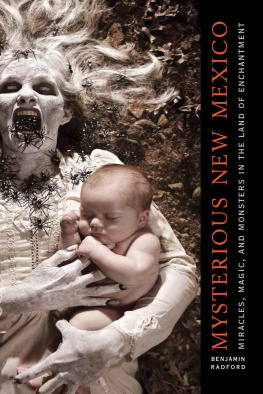

Published by The History Press
Charleston, SC 29403
www.historypress.net
Copyright 2012 by Ray John de Aragn
All rights reserved
First published 2012
e-book edition 2012
Manufactured in the United States
ISBN 978.1.61423.701.3
Library of Congress CIP data applied for.
print ISBN 978.1.60949.760.6
Notice: The information in this book is true and complete to the best of our knowledge. It is offered without guarantee on the part of the author or The History Press. The author and The History Press disclaim all liability in connection with the use of this book.
All rights reserved. No part of this book may be reproduced or transmitted in any form whatsoever without prior written permission from the publisher except in the case of brief quotations embodied in critical articles and reviews.
EN MEMORIAIN MEMORIAM
Juana de Aragn
16491680
Killed at Taos during the Pueblo Indian Uprising
I dedicate this book to our ancestors, the Spanish colonists in New Mexico who went through hardships; died from attack, thirst, hunger and disease; and felt the deep pain of losing loved ones they had to bury on sacred ground. This hidden history needs to be brought to the surface and put into its rightful place on the American record of achievement. Hopefully this book will help with this. I dedicate this book to that effort and to Luca Dolores de Aragn and Linda Dulcinea Isabella de Aragn, who lost their lives at a young age but whom Mie Shu Ou, a dear friend and recognized painter, called, The heart, spirit and soul of Nuevo Mxico.
CONTENTS
INTRODUCTION
In New Mexico, the Spanish settlers formed a vibrant and distinct Hispano culture that today displays a strength gained over four hundred years of settlement. This pride is shown in music, visual art and literature. Contrary to what has been written, New Mexico was not totally isolated from the outside world. When goods and supplies were brought into New Mexico, the colonists had access to literature, such as the novel Lazarillo de Tormes, one of the worlds foremost novels by an unknown author, published in 1554; and the work of Flix Lope de Vega Carpio, the most prolific Spanish dramatist, who wrote over 1,800 plays. By the 1800s, New Mexico authors were getting their books published, among them Ojeada sobre Nuevo Mxico (A Glimpse of New Mexico), written by Antonio Barreiro. Manuel Salazar wrote the first groundbreaking novel in New Mexico, titled La Historia de un Caminante o Sea, Gervacio y Aurora (The History of a Traveler, or Gervacio and Aurora), and Eusebio Chacn published two novels, El Hijo de la Tempestad (Son of the Tempest) and Tras la Tormenta la Calma (The Calm After the Storm).
A Spanish history of New Mexico would not be complete without mention that from before the mid-nineteenth century and up to the twenty-first century, Spanish and bilingual (Spanish-English) newspapers have been published. Almost every single rural village had a printing press. Newspapers such as El Nuevo Mexicano (the New Mexican), La Verdad (the Truth; 1845), La Estrella (Mora, New Mexico), La Gaceta (circa 1850), La Flecha (Wagon Mound), La Cronica del Ro Colorado (the Red River Chronicle; Red River, 1880), El Farol, El Unico Peridico Castellano al sur de Las Vegas y al Oriente de el Ro Grande (the Lantern, the only Castilian Newspaper South of Las Vegas and East of the Rio Grande), El Payo de Nuevo Mjico (1845; payo in reference to being native) and La Voz del Pueblo ( Las Vegas, New Mexico; 1892). The associate editor for La Voz del Pueblo was Ezequiel C. de Baca, born in Las Vegas in 1864. He became New Mexicos first lieutenant governor in 1912. At any given time, over 250 Spanish-language newspapers were being published in New Mexico. This prompted the establishment of the Hispanic American Press Association in New Mexico. Spanish-language publishing houses such as El Nuevo Mexicano in Santa F, La Revista Catolica and the Spanish American Publishing Company in Las Vegas complemented the work of the newspapers by putting out books, pamphlets and other printed materials such as broadsides. The well-known Spanish Sociedad Literaria (Literary Society) met with a renowned group of native Hispano authors for over two decades, starting in 1881 in Las Vegas. In 1884, Jos Segura founded El Boletn Popular (the Popular Bulletin), a newspaper that highlighted the arts and writers in New Mexico. Segura published two novellas by Eusebio Chacn.

La Capilla, Las Vegas, New Mexico. Photograph Ramn Juan Carlos de Aragn, 2011.
In the mid-1800s, Doa Barbara Chvez de Snchez, the niece of general and governor Don Manuel Armijo, owned novels by Victor Hugo. She motivated and inspired her grandson, U.S. senator Dionisio (Dennis) Chvez. Aurora Lucero preserved New Mexico Hispano culture through her writings. Fabiola Cabeza de Bacas book, We Fed Them Cactus, detailing Spanish life and folkways in New Mexico, was a bestseller.
Spanish music and dances from the different provinces of Spain formed the basis for the diverse, yet similar, traditional folk music and dance styles that developed in the Spanish Americas, which are now called folkloric dance and music. For example, New Mexican dance incorporated the Scottish round dance, polkas from Poland, French waltzes and traditional dances from Spain. Luca de Aragn (18921938), born in Las Vegas, New Mexico, was a professional ballet dancer in New York City during the 1920s. She owned the New Mexico Salt Refining Company near Willard. Rosala de Aragn, stage and film actor and singer of popular New Mexican music, continues the tradition of the indomitable spirit of New Mexican Spanish women. Cleofas Martnez de Jaramillo founded the well-known Sociedad Folklrica in Santa F to promote and preserve New Mexico Spanish culture, and J.M. Hilario Alard, who is recognized as a writer of ballads, organized La Banda Lrica, a twenty-five-piece orchestra that played traditional and original New Mexican compositions.
The presentation of dramatic performances in the villages was also significant, with plays like Los Moros y Cristianos, which portrayed the defeat of the Moors by the Christians. Rosa Mara Calles, visual artist (Santera), playwright, producer and director, broke records with her musical stage production Cuento de La Llorona (Tale of the Wailing Woman), based on New Mexicos Spanish colonial history. These historical and artistic admixtures have developed a rich and vibrant Hispanic heritage in the beautiful state of New Mexico.
In 1884, the legendary Elfego Baca fought the famous Wild West gun battle at Frisco, New Mexico, against eighty rowdy Texas cowboys who had been shooting up the peaceful San Francisco village. Baca went on to become a noted western lawman and was immortalized in the film The Nine Lives of Elfego Baca, produced by Disney Studios. In 1892, Felix Martnez was recognized as the founder of what would become New Mexico Highlands University.

Next page










